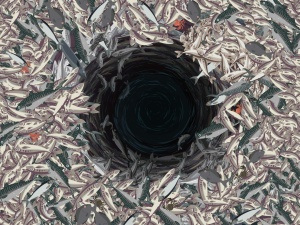What Lies Beneath: Uncovering the truth about Peru’s colossal fishmeal and fish oil industry

Executive summary
Peru is the largest fishmeal and fish oil (FMFO) producer in the world. It accounts for one-third of global production, and exports over 1 million tonnes of FMFO every year. According to the international FMFO trade body, the Marine Ingredients Association (IFFO), the amount of FMFO produced from Peruvian anchovy (anchoveta), the main target species, is enough to supply half the world’s fed farmed fish.
Unslowed by the global Covid-19 pandemic, the sector is expected to generate $2 billion in export revenue in 2020.6 It has customers in countries around the globe, from Asia to Europe and North America.
The industry portrays itself as a model of sustainability, boasting that more of its FMFO plants are certified by the MarinTrust Global Standard for Responsible Supply (formerly IFFO RS) than anywhere else in the world.7 However, in reality, it is plagued by corruption and scandals – from underreporting fish catches and overfishing juvenile fish to diverting thousands of tonnes of anchovy destined for human consumption to FMFO production instead. Recent investigations show that Chimbote, the ‘fishmeal capital of the world,’ remains one of the most polluted places on the planet.
This wanton plundering of Peru’s precious anchovy populations is all the more indefensible, given the key role the species plays in the Humboldt Current System, one of the most productive marine ecosystems on earth. Assessing the status of the anchovy population under a precautionary ecosystem-based approach would require careful consideration of the impacts on fish, bird and marine-mammal populations; however, to the best of our knowledge ecosystem impacts are not given adequate consideration when anchoveta quotas are set, and there is no strategy to do so in the near future. Moreover, while the Peruvian FMFO industry and global aquafeed producers are keen to gain Marine Stewardship Council (MSC) certification of the anchoveta fishery to improve their image, scientists point to numerous risk factors affecting the fishery which increase the likelihood of overexploitation of the stock, particularly when considered alongside the threat posed by climate change. Against this backdrop, experts interviewed for this report expressed concerns about future prospects for the anchoveta fishery – including fears of a potential collapse, similar to that which took place during the 1972 El Niño.
Although Peru is by far the world’s largest FMFO producer, very little is known about its supply chain or relationships with companies in Europe, which trade data shows to be a key FMFO export market. This report sets out to address this knowledge gap by mapping the links between Peruvian FMFO companies and major international feed and aquaculture corporations based in Europe. It shows the farmed fish, such as salmon, that ends up on European plates is produced with FMFO inputs from companies that have been involved in corrupt and unsustainable practices such as fishing high volumes of juvenile anchovies – a practice that can have a devastating impact on marine ecosystems. It also highlights complicity between FMFO companies and Peruvian regulators, which have not only turned a blind eye to the industrial fleet’s plundering of precious fish stocks but also actively encouraged overfishing by setting unscientific and overly high fishing quotas.
To make matters worse, at a time when Peru is struggling to cope with one of the worst Covid-19 crises in Latin America, hundreds of fishermen and FMFO workers have fallen ill, largely as a result of companies’ failure to ensure their safety and provide them with medical care. Industry lobbying overturned an initial decision by the Peruvian government that deemed the FMFO industry non-essential, which led to the resumption of the fishing season, indicating the drive to catch fish to supply the voracious FMFO industry overrode considerations about workers’ health. In the end – after a slow start, owing to a juvenile fishing scandal – the first 2020 season was another bumper season for Peru’s FMFO fleet.
This report provides evidence that two major companies – Peru’s largest FMFO producer, Tecnológica de Alimentos (TASA), and the Norwegian-owned Austral Group – that supply FMFO to customers around the world violated their own health and safety protocols, putting their workers’ health at risk and (at least in TASA’s case) leading to widespread infections.
You might also like...

Caught Out: How UK retailers are tackling the use of wild fish in their aquaculture supply chains
This report scores the top 10 UK supermarkets to assess how effectively they are addressing the ocean sustainability implications of the farmed seafood they sell, which remains largely reliant on the use of ...

Erwischt: Wildfisch als Fischfutter für Aquakulturen!
This report outlines how effectively Austrian retailers are safeguarding the health of the oceans and fish welfare through the sustainability of their aquaculture supply chains. Read our German language report:

Fishing for Catastrophe
This report presents damning evidence that the production of fishmeal and fish oil for use in the growing global aquaculture industry is destroying fish stocks, marine ecosystems and traditional livelihoods.